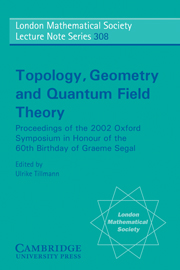 Topology, Geometry and Quantum Field Theory
Topology, Geometry and Quantum Field Theory Book contents
- Frontmatter
- Contents
- Preface
- Participants
- Introduction
- Part I Contributions
- 1 A variant of K-theory: K±
- 2 Two-vector bundles and forms of elliptic cohomology
- 3 Geometric realization of the Segal–Sugawara construction
- 4 Differential isomorphism and equivalence of algebraic varieties
- 5 A polarized view of string topology
- 6 Random matrices and Calabi–Yau geometry
- 7 A survey of the topological properties of symplectomorphism groups
- 8 K-theory from a physical perspective
- 9 Heisenberg groups and algebraic topology
- 10 What is an elliptic object?
- 11 Open and closed string field theory interpreted in classical algebraic topology
- 12 K-theory of the moduli space of bundles on a surface and deformations of the Verlinde algebra
- 13 Cohomology of the stable mapping class group
- 14 Conformal field theory in four and six dimensions
- Part II The definition of conformal field theory
- Foreword and postscript
- The definition of CFT
- References
7 - A survey of the topological properties of symplectomorphism groups
Published online by Cambridge University Press: 06 November 2009
- Frontmatter
- Contents
- Preface
- Participants
- Introduction
- Part I Contributions
- 1 A variant of K-theory: K±
- 2 Two-vector bundles and forms of elliptic cohomology
- 3 Geometric realization of the Segal–Sugawara construction
- 4 Differential isomorphism and equivalence of algebraic varieties
- 5 A polarized view of string topology
- 6 Random matrices and Calabi–Yau geometry
- 7 A survey of the topological properties of symplectomorphism groups
- 8 K-theory from a physical perspective
- 9 Heisenberg groups and algebraic topology
- 10 What is an elliptic object?
- 11 Open and closed string field theory interpreted in classical algebraic topology
- 12 K-theory of the moduli space of bundles on a surface and deformations of the Verlinde algebra
- 13 Cohomology of the stable mapping class group
- 14 Conformal field theory in four and six dimensions
- Part II The definition of conformal field theory
- Foreword and postscript
- The definition of CFT
- References
Summary
Abstract
The special structures that arise in symplectic topology (particularly Gromov–Witten invariants and quantum homology) place as yet rather poorly understood restrictions on the topological properties of symplectomorphism groups. This article surveys some recent work by Abreu, Lalonde, McDuff, Polterovich and Seidel, concentrating particularly on the homotopy properties of the action of the group of Hamiltonian symplectomorphisms on the underlying manifold M. It sketches the proof that the evaluation map π1(Ham(M)) → π1(M) given by {øt} ↦ {øt (x0)} is trivial, as well as explaining similar vanishing results for the action of the homology of Ham(M) on the homology of M. Applications to Hamiltonian stability are discussed.
Overview
The special structures that arise in symplectic topology (particularly Gromov–Witten invariants and quantum homology) place as yet rather poorly understood restrictions on the topological properties of symplectomorphism groups. This article surveys some recent work on this subject. Throughout (M, ω) will be a closed (ie compact and without boundary), smooth symplectic manifold of dimension 2n, unless it is explicitly mentioned otherwise. Background information and more references can be found in.
The symplectomorphism group Symp(M, ω) consists of all diffeomorphisms ø : M → M such that ø*(ω) = ω, and is equipped with the C∞-topology, the topology of uniform convergence of all derivatives. We will sometimes contrast this with the C0 (i.e. compact-open) topology.
- Type
- Chapter
- Information
- Topology, Geometry and Quantum Field TheoryProceedings of the 2002 Oxford Symposium in Honour of the 60th Birthday of Graeme Segal, pp. 173 - 193Publisher: Cambridge University PressPrint publication year: 2004
- 10
- Cited by


